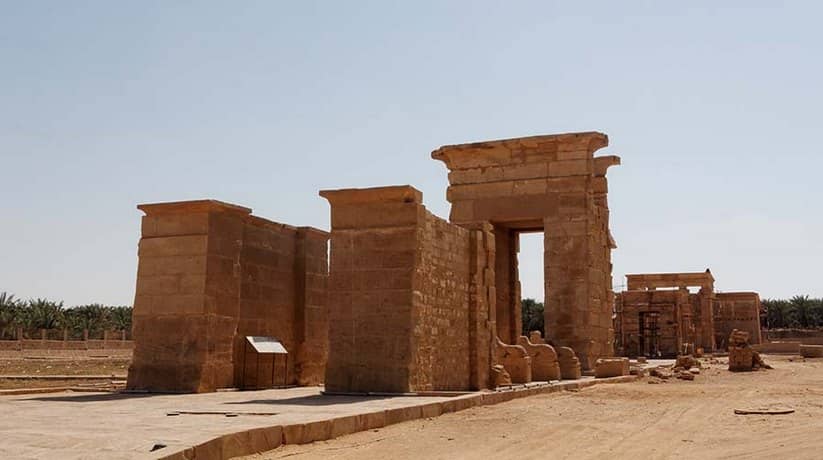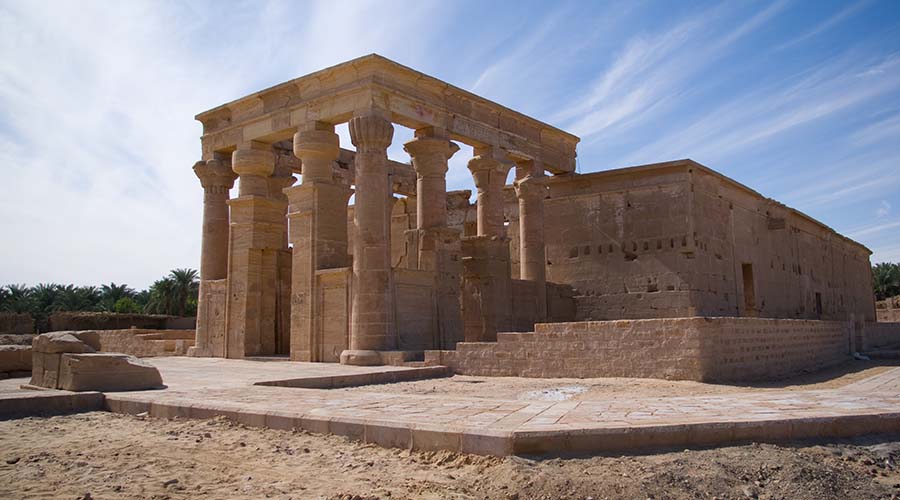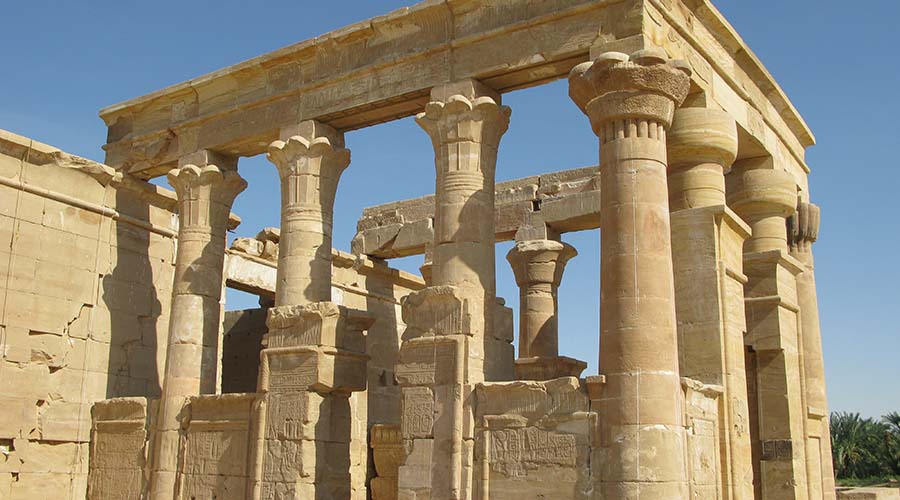Hibis temple Kharga Oasis information, tours, prices and online booking
Hibis temple Kharga oasis was once part of the ancient capital of Kharga. In fact, it known as Hebet, meaning “the plough”, or Hibitonpolis (city of the plough) to the Greeks. It situated in a palm-grove where it dominates the desert road. Moreover, it is about 2km north of El Kharga. Furthermore, it is the largest and best-preserved temple of its period in the oasis. Much of the ancient town, which covered about 1km square, now lies buried beneath the modern cultivation. But excavations in the early part of the 20th century led by Herbert Winlock of the Metropolitan Museum of Art. He uncovered a few mud-brick houses with vaulted ceilings and fresco paintings on the edges of the town.
In fact, it is not clear how long Hebet remained capital of the oasis. Recent exploration by the local Supreme Council of Antiquities (2002) unearthed a cemetery. It is at the site which thought to date from the Second Intermediate Period and New Kingdom. The excavations in an area to the south of the temple have revealed that the Christian era buildings. In fact, they date back 350 AD and which destroyed by a great fire. This indicates a very long period of occupation. The earliest extant parts of Hibis temple date to the reign of the Persian ruler Darius I. It is although it probably begun during the Dynasty XXVI reigns of Psamtek II, Apries and Amasis II. Maybe they built on the site of an even earlier structure for which foundations found by Winlock.
More information about Hibis temple Kharga Oasis:
The temple constructed from local limestone blocks on the edge of a small sacred lake. Moreover, it dedicated to the Theban triad of Amun-Re, Mut and Khons. Furthermore, it decorated by Darius I, and possibly Darius II. It is with additions by Nectanebo II and the Ptolemies. The Christian church constructed on the northern side of the portico during the 4th century AD. It was Nectanebo I and Nectanebo II who surrounded the temple with a stone enclosure wall. That is why it now approached through a series of gateways which lead to the inner parts. A sphinx-lined avenue led west from a quay on the edge of the lake. It is along a paved processional way which laid by an official of the oasis named Hermeias. In fact, it was during the 3rd century AD. A massive sandstone gateway through an outer enclosure wall still stands.
In fact, it is almost 5m tall and constructed during the Ptolemaic or Roman periods. Numerous inscriptions and decrees written on the gateway of Hibis temple in Kharga Oasis. In fact, it is a kind of notice-board which greatly contributed to our understanding of Roman rule in the oases. These include a variety of topics such as taxation, inheritance and the court system and rights of women. Moreover, it is with the earliest dating to AD49. On the inside of the gateway are the bases of two obelisks or colossal statues. The Dynasty XXX construction of the inner enclosure wall enclosed a monumental kiosk. In fact, they fronted the main part of the temple. Because of the wide span of the kiosk (7.4m) the roof supported by wooden beams.
Further information about Hibis temple Kharga Oasis:
The composite capitals on the columns are the earliest of this type which known in Egypt. Although thought to be built by Nectanebo I only the cartouches of Nectanebo II remain on the decoration. A larger hypostyle hall, rather than the traditional pillared court, added to the original temple. In fact, it was by Hakor (Achoris) of Dynasty XXIX. Moreover, it was this king who strengthened the foundations and buttressed the west wall against collapse. It begun in the original structure soon after it built. The hall contains 12 palm-columns of an early composite type. Moreover, it also has those at the front open on to a narrow courtyard. The inner parts of the temple, constructed over the foundations of a New Kingdom shrine of Amun.
In fact, they illustrate the transition between New Kingdom and Ptolemaic architecture. Moreover, they show that what we consider to be Ptolemaic inventions actually originated in the Saite or Late Period. Behind the hypostyle hall of Hakor is an early form of pronaos. It is with four smooth papyrus columns and screen walls. Thought to be similar in style to the temple of Shoshenq I at El Hiba. The earlier hypostyle hall lies beyond this and contains four columns. In fact, it is with an offering chamber, sanctuary and chapel of the deified king at the rear. There are several side-chambers and stairs lead up to the roof. The roof contains an extensive complex of cult chambers dedicated to Osiris. Hibis temple Kargha Oasis is the finest example we have in Egypt of a Persian Period temple.
More details about Hibis temple Kharga Oasis:
Moreover, its reliefs very well-preserved owing to its burial in sand for many centuries. The temple contains a rich religious iconography, Moreover, it also has a wealth of theological texts in a very unusual style. It is perhaps the influence of a local style of art which until recent years has barely been studied. One large and unique wall-relief depicts a winged figure of Seth, god of the desert oases. In fact, it is with the head of a falcon. He painted blue, a color usually reserved for air deities and is fighting the serpent Apophis. Many deities represented in the sanctuary and Min, another desert god, also venerated here. A complete wooden codex from Hibis purchased on the antiquities market in Luxor in 1906. The codex, now in the Ashmolean Museum, Oxford, written in Greek.
Moreover, it contained two texts, the first a list of names and accounts and the second. Furthermore, they dated circa 246-249AD, a report by a government official detailing a survey of water sources in the oasis. Hibis temple has undergone sporadic excavation and restorations throughout the 20th century. Efforts made to control the subterranean water. In fact, the water risen sharply as a result of irrigation projects in the surrounding area. Moreover, it threatened the structure with total collapse. This is not only a recent problem in fact. The temple constructed on unstable ground and attempts by Ahmed Fakhry in 1980. In fact, it was to protect the temple by building a cement ceiling resulted in putting more stress on the walls, accelerating the deterioration.
Further details about Hibis temple Kharga Oasis:
The situation became such that, in 1989, the temple declared off-limits to the public. It left unattended, with its scaffolding still in place. In 2000 the Egyptian Ministry of Culture gave the go-ahead for a huge salvage operation. In fact, it planned for several decades, to resume. Moreover, the plan was to dismantle the temple, consolidate the blocks from which it built. It reconstructs it in a more suitable dry and rocky area some 400 meters north of its present location. Unfortunately, when this long-envisioned and frequently- delayed project eventually began, it proved to be totally unsatisfactory.
Far from salvaging the Hibis temple Kharga oasis, the work appeared to be accelerating the decay. The project to dismantle and relocate it postponed indefinitely. It was while restorations of the temple in its present position continue. Meanwhile scholars studied the temple’s texts. An epigraphic survey of the graffiti carried out by an American team. In fact, it led by Eugene Cruz-Uribe and currently Harco Willems of Leuven University. It conducted a four year research project investigating the Theban theological creation texts. Hibis temple now officially open to tourists and tickets are sold costing LE50.
















